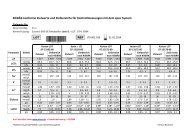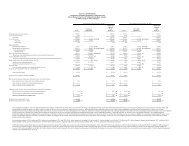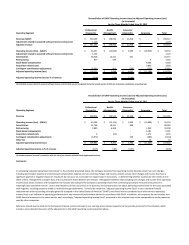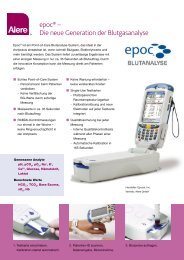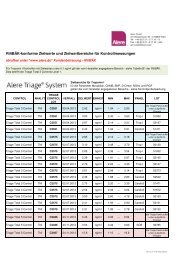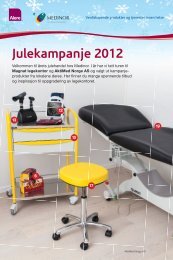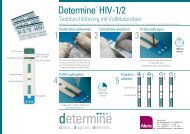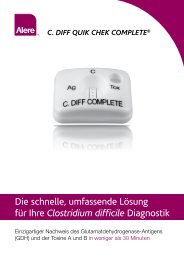Broschüre Actim PROM Partus - Alere
Broschüre Actim PROM Partus - Alere
Broschüre Actim PROM Partus - Alere
Erfolgreiche ePaper selbst erstellen
Machen Sie aus Ihren PDF Publikationen ein blätterbares Flipbook mit unserer einzigartigen Google optimierten e-Paper Software.
Probenentnahme<br />
Einfache Testdurchführung:<br />
<strong>Actim</strong> ® <strong>Partus</strong><br />
Vorzeitige<br />
Wehen<br />
Extraktion<br />
Eintauchen des<br />
Teststreifens<br />
Ablesen des<br />
Ergebnisses<br />
Ergebnis<br />
Legen Sie die Spitze des Tupfers<br />
10-15 Sekunden in die Zervix.<br />
So nimmt der Tupfer genügend<br />
Zervikalsekret auf.<br />
5<br />
Min.<br />
<strong>Actim</strong> ® <strong>PROM</strong><br />
Verdacht auf<br />
vorzeitigen<br />
Blasensprung<br />
Nehmen Sie eine Probe der Vaginalflüssigkeit,<br />
indem Sie den Tupfer<br />
10-15 Sekunden im hinteren<br />
Scheidengewölbe lassen.<br />
Halten Sie den Tupfer in die<br />
Extraktionslösung und mischen Sie<br />
sie kräftig 10-15 Sekunden lang.<br />
Drücken Sie den Tupfer an der<br />
Röhrchenwand gut aus.<br />
Tauchen Sie die gelbe Zone des<br />
Teststreifens so lange in die extrahierte<br />
Probe, bis die Feuchtigkeit in<br />
die Ergebniszone aufgestiegen ist.<br />
Entnehmen Sie den Teststreifen<br />
dann aus der Lösung und legen Sie<br />
ihn horizontal ab.<br />
Lesen Sie das Ergebnis<br />
nach 5 Minuten ab.<br />
2 Linien<br />
= positives Testergebnis<br />
1 Linie<br />
= negatives Testergebnis<br />
Die Kontroll-Linie muss erscheinen,<br />
ansonsten ist das Testergebnis<br />
ungültig.<br />
<strong>Actim</strong> ® <strong>PROM</strong><br />
Positiv: 2 Banden<br />
Es wurde ein Blasensprung<br />
detektiert. Je nach SSW<br />
entsprechend der Leitlinien<br />
fortfahren.<br />
Negativ: eine blaue Kontrollbande<br />
Ein Blasensprung konnte nicht<br />
festgestellt werden. Mit Hilfe<br />
von <strong>Actim</strong> ® <strong>Partus</strong> ein erhöhtes<br />
Frühgeburtsrisiko ausschließen.<br />
Bestellinformationen<br />
<strong>Actim</strong> ® <strong>PROM</strong> 1 Tests<br />
3 Tests<br />
10 Tests<br />
20 Tests<br />
<strong>Actim</strong> ® <strong>Partus</strong> 1 Tests<br />
3 Tests<br />
10 Tests<br />
30830ETAC<br />
30833ETAC<br />
30831ETAC<br />
30832ETAC<br />
31930ETAC<br />
31933ETAC<br />
31931ETAC<br />
<strong>Actim</strong> ® <strong>Partus</strong><br />
Es liegt ein erhöhtes Risiko<br />
für eine Frühgeburt vor.<br />
Ein Blasensprung sollte<br />
ausgeschlossen werden.<br />
Ein erhöhtes Frühgeburtsrisiko kann<br />
für die nächsten 7 Tage mit einer<br />
Zuverlässigkeit von 92-98,5 %<br />
ausgeschlossen werden.<br />
Referenzen:<br />
1. European foundation for the care of newborn infants; EU Benchmarking report<br />
2009/2010<br />
2. Mohr T., Premature rupture of the membranes. Gynakol Geburtsmed Gynakol<br />
Endokrinol (2009) 5:28–36.<br />
3. Erdemoglu E and Mungan T., Significance of detecting insulin-like growth<br />
factor binding protein-1 in cervicovaginal secretions: Comparison with<br />
nitrazine test and amniotic fluid volume assessment. Acta Obstet Gynecol<br />
Scand (2004) 83:622-626.<br />
4. Wathen NC, Egembah S, Campbell DJ, Farkas A, Chard T., Levels of Insulinlike<br />
Growth Factor Binding Protein-1 increase rapidly in amniotic fluid from 11<br />
to 16 weeks of pregnancy. Journal of Endocrinology. 1993;137:R1–R4.<br />
5. Rutanen E-M, Pekonen F, Kärkkäinen T., Measurement of insulin-like growth<br />
factor binding protein-1 in cervical/vaginal secretions: comparison with the<br />
ROM-check Membrane immunoassay in the diagnosis of ruptured fetal<br />
membranes. Clin Chim Acta (1993) 214:73-81.<br />
6. Martinez de Tejada B et al., Can we improve the diagnosis of rupture of<br />
membranes? The value of insulin-like growth factor binding protein-1. BJOG<br />
(2006) 113:1096-1099.<br />
7. Ragosch V et al., Insulin like growth factor binding protein 1 (IGFBP-1) und<br />
fetales Fibronectin in der Diagnostik eines vorzeitigen Blasensprunges.<br />
GebFra (1996) 56:1-6.<br />
8. Akercan F et al., The value of the insulin-like growth factor binding protein-1 in<br />
the cervical-vaginal secretion detected by immunochromatographic dipstick<br />
test in the prediction of delivery in women with clinically unconfirmed preterm<br />
premature rupture of membranes. Eur J Obstet Gynecol Reprod Biol (2005)<br />
121:159-163.<br />
Informieren Sie sich unter 02 21 - 27 14 30 oder besuchen Sie uns unter www.alere.de<br />
Das <strong>Alere</strong> Logo und <strong>Alere</strong> sind Marken der <strong>Alere</strong> Unternehmensgruppe. <strong>Actim</strong> ist eine Marke der Medix Biochemica.<br />
<strong>Alere</strong> GmbH<br />
Am Wassermann 28 · D-50829 Köln<br />
Tel: +49 (0) 2 21 - 2 71 43 - 0<br />
Fax: +49 (0) 2 21 - 2 71 43 - 400<br />
serviceDE@alere.com · www.alere.de<br />
9. Dögl M, Skogvoll E, Heimstad R., Cervical insulin-like growth factor binding<br />
protein-1 (IGFBP-1) to predict spontaneous onset of labor and induction to<br />
delivery interval in post-term pregnancy. Acta Obstet Gynecol Scand. (2011)<br />
90:57-62.<br />
10. Riboni F et al., Biochemical markers predicting pre-term delivery in<br />
symptomatic patients: phosphorylated insulin-like growth factor binding<br />
protein-1 and fetal fibronectin. Arch Gynecol Obstet. (2011) Jan 28. Epub<br />
ahead of print.<br />
11. Eroglu D et al., Prediction of preterm delivery among women with threatened<br />
preterm labor. Gynecol Obstet Invest (2007) 64:109-116.<br />
12. Tanir HM, Sener T, Yildiz Z., Cervical phosphorylated insulin-like growth factor<br />
binding protein-1 for the prediction of preterm delivery in symptomatic cases<br />
with intact membranes. J Obstet Gynaecol Res (2009) 1:66-72.<br />
13. Danti L et al., The combination of short cervical length and phIGFBP-1 in<br />
the prediction of preterm delivery in symptomatic women. J Matern Fetal<br />
Neonatal Med. (2011) Jan 19. Early Online, 1-6.<br />
14. Rahkonen L et al., Factors affecting decidual IGFBP-1 levels in the vagina<br />
and cervix in the first and mid-second trimester of pregnancy. BJOG. (2009)<br />
Jan;116(1):45-54. Epub 2008 Nov 11.<br />
15. Ting HS et al., Comparison of bedside test kits for prediction of preterm<br />
delivery: phosphorylated insulin-like growth factor binding protein-1<br />
(pIGFBP-1) test and fetal fibronectin test. Ann Acad Med Singapore (2007)<br />
36:399-402.<br />
<strong>Alere</strong> GmbH<br />
Estermannstr. 17 · A-4020 Linz<br />
Tel: +43 (0) 7 32 - 77 10 77<br />
Fax: +43 (0) 7 32 - 77 10 77 23 91<br />
serviceAT@alere.com · www.alere.at<br />
<strong>Alere</strong> GmbH<br />
Moosacherstrasse 14 · CH-8804 Au-Wädenswil<br />
Tel: +41 (0) 44 782 60 70<br />
Fax: +41 (0) 44 782 60 77<br />
infoCH@alere.com · www.aleregmbh.ch<br />
© <strong>Alere</strong> GmbH 2012 · Alle Rechte vorbehalten · Dok.-Nr. 39V-0004 · Version 02 · FLY



